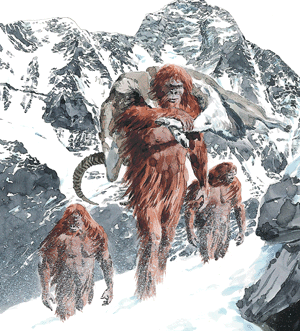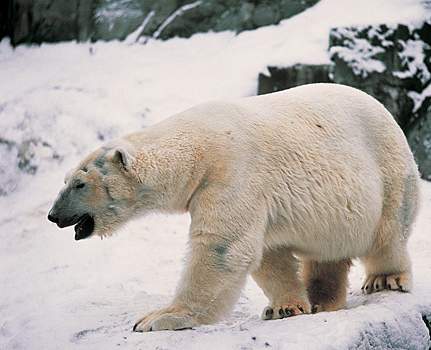Yeti? Yes. Abominable Snowman? Not So Much.
Friday, October 18th, 2013October 18, 2013
Sensitive DNA tests on samples of hair recovered from the Himalaya indicate that the Yeti may actually exist, reported Bryan Sykes, a professor of genetics at the University of Oxford in the United Kingdom. Although this unexpected finding could potentially rank as one of the greatest zoological discoveries in history, fans of the legendary Yeti may be somewhat disappointed. The tests also show that the Yeti is not what people think it is.
The Yeti, which has also been called the Abominable Snowman, is said to be a creature with a human-like face and ape-like body that lives on Mount Everest and other mountains of the Himalaya range. According to local legend, the Yeti sometimes comes down from the mountains to attack villagers.

The legendary Yeti is a ape-like creature with a human-like face who lives in remote areas of the Himalaya. The real Yeti is probably something entirely different. (World Book illustration by Ted Lewis)
Many people are fascinated by the idea that a large primate like the Yeti–or its American cousin, Bigfoot–could survive in remote wilderness unexplored by modern science. Cryptozoologists, people who study and search for legendary creatures, have investigated the Yeti for decades. Sensational reports of Yeti sightings have been exposed as hoaxes and fakes in the past, and this has led many skeptics to dismiss the creature as pure fantasy.
However, reports of Yeti sightings continue to this day, and cryptozoology enthusiasts argue they demand explanation. Sykes made news in 2012 when he publicly asked wildlife scientists, museums, and Yeti believers to send him written descriptions and photos of any evidence they might have of the creature. If the descriptions looked promising, the researchers requested the physical samples and then tested the samples’ DNA to determine which species they came from.
Sykes and his team conducted sophisticated genetic tests on two samples of supposed Yeti hair discovered in the Himalaya: one found in Ladakh–a region in Jammu and Kashmir, the northernmost state in India; and another from Bhutan to the east. They compared the samples to the genetic codes of other animals from collections gathered over many years from all over the world. The tests revealed that the hair was from a mammal, but it did not match samples from known primates. Surprisingly, the DNA from the two samples matched up almost exactly with DNA from the 40,000-year-old jawbone of a Norwegian polar bear.
The researchers do not believe that the Himalayan Yeti actually represents an isolated population of polar bears. Instead, they theorize that the region is home to an unknown hybrid bear species that developed from matings between polar bears and brown bears somewhere in northern Asia during the last Ice Age, when the ranges of those bears overlapped. They point to antique Tibetan texts that describe the Yeti as a shy bear-like creature that is sometimes aggressive towards humans when encountered in its remote mountain domain. The scientists also point out that the animal may still survive in remote areas of the Himalaya, giving Yeti enthusiasts hope that the legendary creature may one day be found.
Additional World Book articles:



